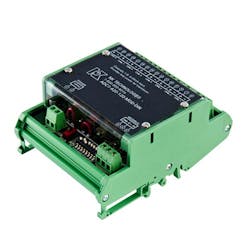A great many industrial sensors — flow, level, temperature, pressure, pH, and the list goes on — produce a 4-20 mA output, but today's factories increasingly need digital inputs via standard field buses. These ADC Signal Converters make that possible, converting up to eight 4–20 mA sensor outputs using a single network address. Model configurations include eight two-wire (powered from the ADC converter) or eight four-wire (powered from an external source), or four of each type.The ADC converter can be configured to be powered by 120 or 240 VAC. With the digital Modbus output scaled for zero (4 mA) to 100 percent (20 mA) the signal will represent whatever is needed for a specific application.
For example, in a photovoltaic power system, each of the panel outputs can be monitored for current output, and each string output can be monitored after the combiner box. The voltage can be measured at any point. Each of these values are fed into the ADC converter which produces a Modbus formatted value. This single Modbus address connects to the network, and each data point can be logged and utilized as needed.
Other examples include machine control, where the converter can combine several analog signals into a single Modbus address to enable Web viewing of data and SCADA systems, to report and record current, voltage, power, pressure, frequency and flow by using existing sensors but adding network communication easily.
For more detailed information on this product, go to http://nktechnologies.com/signal-converters/adc-analog-digital-conditioner.html




